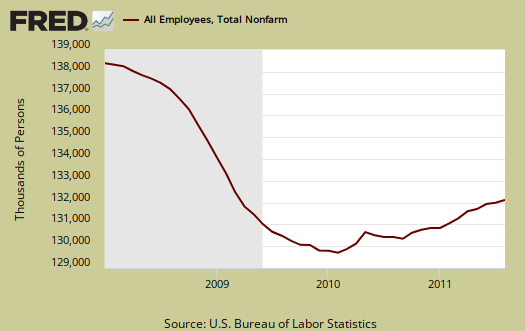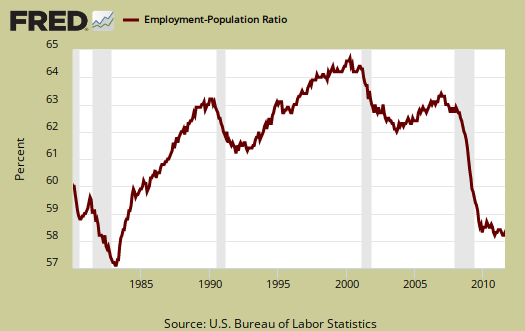The August 2011 monthly unemployment figures show the official unemployment rate remained at 9.1% and the total jobs gained were 0. That's right, zero. Total private jobs came in at 17,000 with government jobs dropping -17,000.

Below is the nonfarm payroll, the total number of jobs, seasonally adjusted. Since the start of the great recession, declared by the NBER to be December 2007, the United States has officially lost 6.85 million jobs. That does not take into account additional jobs needed to employ the United States increased population, but does include the jobs added over the over 3 and a half years, or 44 month time period.

Below is a running tally of how many official jobs permanently lost since the official start of this past recession (recall the private NBER has declared the recession over!). This is a horrific tally and notice this isn't taking into account increased population growth, which implies the United States needs to create at least 10.8 million jobs or self-employment. This estimate assume a 62.7% civilian non-institutional population to employment ratio, as it was in December 2007, which implies an additional 3.94 million jobs needed over a 3.42 month time period.
If one takes the current civilian non-institutional population and the December 2007 to employment ratio and then subtracts off the current number of payroll jobs, the number of jobs to get to pre-recession levels is much worse, 16.1 million jobs. This doesn't take into account population subset fluctuations, for example, those retired percentages increasing. This isn't taking into account agriculture workers and self-employed, currently at 2.36 million and 8.55 million, respectfully. Bear in mind payrolls only counts nonfarm jobs and many people work 2 to 3 jobs to get by. Part-time workers are at record highs with 8.83 million of the 27.03 million part-timers working low hours because they cannot get full time jobs.

Striking Verizon workers, who are not really unemployed, made it into both the CPS and establishment surveys. Supposedly an artificial 45,000 jobs were missing from non-farm payrolls due to the timing of surveys and the strike. Even if these workers are added back into the count, payrolls jobs is still within the margin or error and shows no job growth.
The increasingly low labor participation rate is now at 64%. If we go back to December 2007, the labor participation rate was 66%. The highest civilian labor participation rate was in January 2000, at 67.3%. What this means is there are over 4.8 million people not be accounted for in the official unemployment rate, in other words counted as employed or unemployed, who probably need a job and can't find one. That's in addition to the 13.97 million of the official unemployed.

The employment to population ratio is now 58.2% which is at record lows. You have to go back to August 1983 to find such low ratios. This was when a severe recession occurred. The uber-low ratios are not a structural change, such as all families decided to have a stay at home caretaker, or magically a host of people could retire early, this is people dropping out of the count. They need a job, but stopped looking, fell off of the rolls, stop being counted.
These numbers are important because unemployment is a ratio, percentage or during a limited time period, the number of people actively looking for a job and counted. Many people are not counted in the official unemployment statistics, due to definitions, but obviously when one has more potential workers and less jobs, that metric doesn't bode well for America.

One needs at least 98,000 and some estimate up to 375,000 permanent full time jobs, added each month just to keep pace with U.S. civilian workforce population growth. That's not general population, that's the group needing a job.
This unemployment report literally is a big fat zero on jobs and even if one negates the Verizon strike, doesn't have enough jobs to keep up with population growth. It's so dismal maybe now, politicians will realize we have a jobs crisis going on for over 44 months!

This is the first in a series of job articles
This is the first in a series of articles on the employment report, the job situation, the labor situation and the unbelievably pathetic political response. Check back in an hour or two.
Great--But Don't Let This Ruin Your Labor Day Weekend
As always I'm eager to read what you're going to write about my "favorite" topic, unemployment.
Still all this stuff can make a person's head explode after awhile. I am somewhat shielded by my ignorance of how statistics should be produced and how far from the ideal some of the data and methods used are -- plus there's the holes, too, the things not even measured that should be.
But you of course understand what is and what should be and suffer accordingly.
So please pace yourself. Get out and have some fun too.
Thanks again for all you do. I cannot tell you how much I've come to rely on your steady and scrupulously honest voice and your insistence that the truth be told about the economic emergency that's engulfed us.
will do, it's jobs, jobs, jobs
I'm having to stop and deal with some admin stuff, the site performance has slowed to a crawl. That said, I plan on writing a series of posts on employment, jobs, from the numbers to policy.
Enough is enough and this is just getting outrageous.
Dean Baker Answered Your Question
Weren't you wondering recently how Dean Baker at Beat the Press [one of the sites listed in the left column] arrived at his assumption of 90,000 new labor market entrants each month?
I saw the story at the left and you are so busy I want to make sure you see what he says.
It seems to me though that since so many of the 1,781,000 he cites are from abroad on work visas, a far higher percentage than 64% of them would be working. Surely there would be far fewer retirees among them than in the native born US population. 90,000 just seems too low, especially vs. the much high figures others use. Interesting that he does not speculate why others' figures are so much higher.
"There is another way to back out a growth number. The Bureau of Labor Statistics estimates that the civilian non-institutionalized population over age 16 increased by 1,781,000 people over the last 12 months. If we assume that 64 percent of this increment to the above 16 age population is employed (roughly the 2000 percent) then this would imply an increase in employment of 1,140,000.
However, this would overstate payroll employment slightly since roughly 6 percent of the workforce is self-employed. If we assume that 6 percent of the increment is also self-employed, this implies that roughly 1,070,000 payroll jobs are needed to keep pace with the growth of the labor force, or just under 90,000 a month."
http://www.cepr.net/index.php/blogs/beat-the-press/how-many-jobs-does-it...
Dean Baker's 90k jobs per month to keep up with population
I'll try to write up another exercise for the reader on these numbers and reference his method vs. some others. I think it's way too low but the fundamental problem here is getting that monthly non-institutional civilian population number and even yearly, accurate.
It's good though he shows his methods. I actually left a comment on his blog where the problem is, it's with the low ball on non-institutional population as well as in payrolls, a job is a job and it doesn't matter if it's 10 hours per week, whereas the CPS are people.